There’s something about Montana’s sky at night. The vast, open space speckled with stars and the light of the milky way. It leaves you feeling so small and irrelevant, but so fulfilled.
While many places in the state offer great opportunities to see the Montana sky at night, there are some specific locations, including some officially designated dark sky areas, that make for exceptional stargazing in Montana. These spots shouldn’t be missed.
If you’re curious about where to stargaze in Montana, then you’re in the right place. Here are the 10 best places to see the Montana sky at night.
In this article:
- Dark sky areas in Montana
- Glacier National Park
- Medicine Rocks State Park
- Brush Lake State Park
- Yellowstone National Park
- Beartooth Scenic Highway
- Big Sky
- Montana Hot Springs
- Paradise Valley
- Small towns
- Anywhere outside any city or town
Dark sky areas in Montana
There are three dark sky areas in Montana: Medicine Rocks State Park, Brush Lake State Park, and Glacier National Park. However, these are not the only places that offer excellent stargazing in Montana. Montana has many national parks, towns, and scenic drives that offer excellent views of the skies.
Is Montana good for stargazing?
Montana is an excellent place for stargazing. It’s easy to find areas in Montana with clear skies that are free from light pollution. Montana’s low population, small cities, and vast open space make it an easy place to find undisturbed views of the night skies.
Can you see the Milky Way in Montana?
You can see the Milky Way from anywhere in Montana. The best time to see the Milky Way in Montana is from late March to late August, during clear weather. However, the Milky Way is still visible in Montana from February to October. Views of the Milky Way in Montana are always better if you’re located far from a city or town, such as in Glacier National Park or Brush Lake State Park.
When can you see the Milky Way in Montana?
Because Montana is a high-altitude state, you can see the Milky Way almost year-round. The best time to see the Milky Way in Montana is from late March to late August. However, you can see the Milky Way in Montana anytime from February to October.
While you don’t actually need binoculars to see the stars and galaxies of the Milky Way from Montana, they do make a world of difference.
Plus, they’re great for viewing canyons, mountainsides, and wildlife while touring the state.
There are an infinite number of brands out there, so we selected the top three binoculars for stargazing according to space.com below. Some are large, some are small. Pick the ones that suit you best:
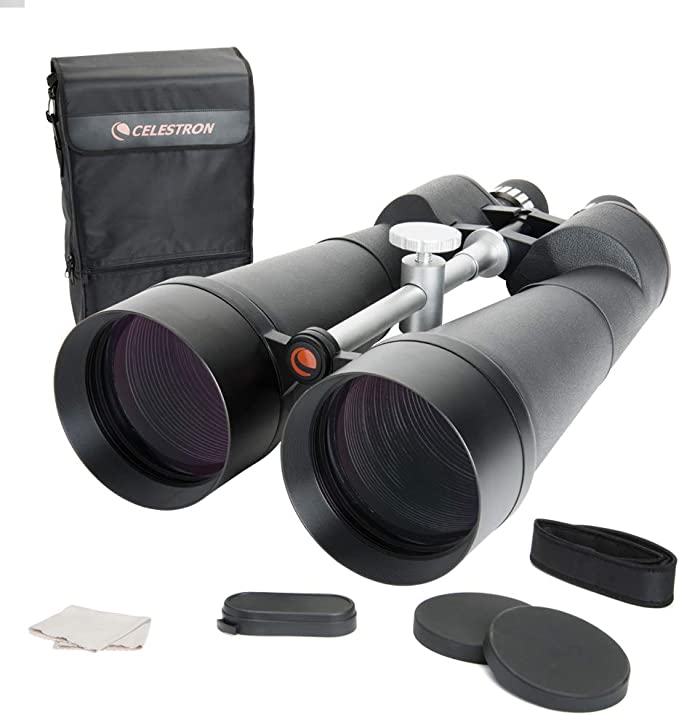
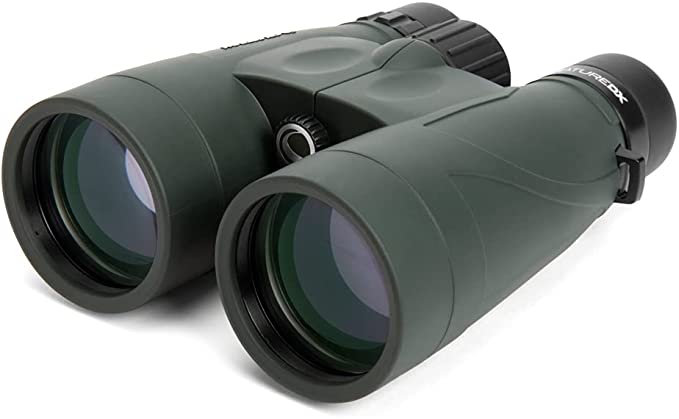
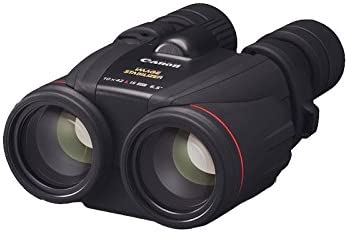
Can you see the northern lights in Montana?
You can see the northern lights in some northern locations of Montana, such as Glacier National park or Brush Lake State Park. While sitings of the northern lights in Montana aren’t common, the state’s undeveloped public lands and vast open spaces make it possible.
Can you see the northern lights in Whitefish, Montana?
Yes, you can see the northern lights in Whitefish, Montana. This is thanks to Whitefish’s low levels of light pollution and clear skies. Many people have also reported seeing the northern lights from nearby Whitefish Lake.
Where can I go stargazing in Montana?
The best places to go stargazing in Montana are:
- Glacier National Park
- Medicine Rocks State Park
- Brush Lake State Park
- Yellowstone National Park
- Beartooth Scenic Highway
- Big Sky
- Montana Hot Springs
- Paradise Valley
- Small towns
- Anywhere outside the cities
Because Montana has so few people and such a vast amount of open space, there are great stargazing opportunities from almost anywhere in the state.
Let’s look at each one of these places in detail.
10 best places for stargazing in Montana – Montana’s sky at night
1. Glacier National Park – Official dark sky area in Montana
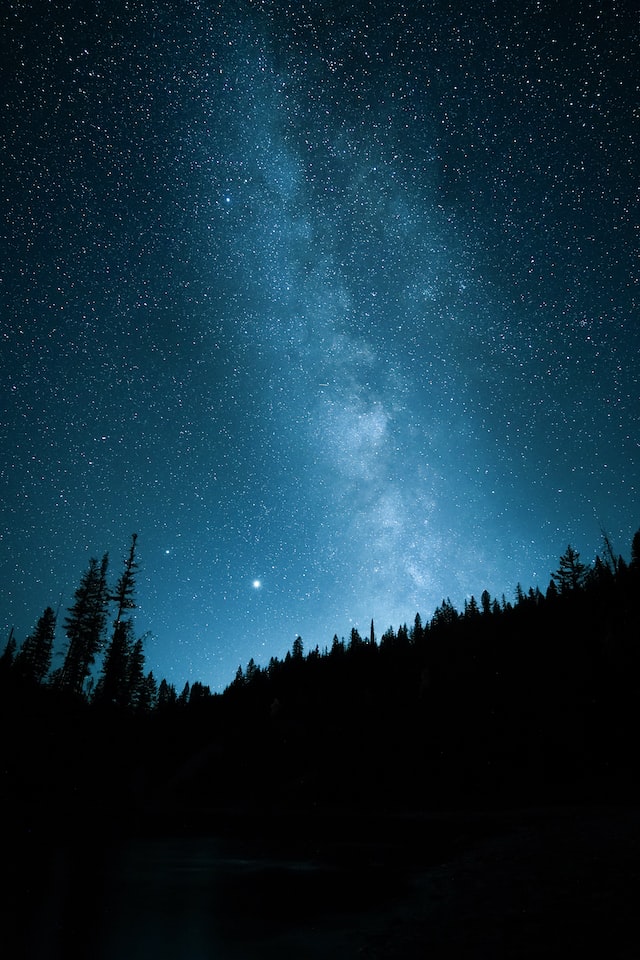
Glacier National Park is one of the best places to see the stars in the Montana night sky for two reasons:
✅ Firstly, it’s a perfectly intact ecosystem featuring beautiful mountain lakes, waterfalls, mountain peaks, and the stunning “Going-to-the-sun road” (GTSR). This makes for an incredible setting for seeing Montana’s stars at night.
✅ Secondly, Glacier National Park is an official dark sky area (the official term is Dark Sky Preserve, or DSP), meaning it has received designation from the International Dark-Sky Association as a place with exceptionally low light pollution, ideal for stargazing. The park management upholds this designation by practicing responsible lighting policies.
Naturally, Glacier National Park stargazing is a joy. If you find yourself spending the night here, then you’re in store for some of the best stargazing in Montana.
Sit fireside at your campsite, venture off to a hilltop (bring your bear bells and bear spray!), or take a drive up the GTSR and find a rest stop to view the Montana sky at night as the valley rests below. Any spot in Glacier offers wonderful views of the Montana sky at night.
Best places to stargaze in Glacier National Park at night
- Drive to
- Going-to-the-Sun Road (GTSR). This is one of the highlights of the Park–an engineering marvel that cuts across the mountainsides, climbing up to Logan Pass. The road traverses below towering peaks looming over waterfalls and lush green valleys below. The Jackson Glacier Overlook, Lunch Creek Pullout, Paradise Meadow (when driving uphill towards Logan Pass), or any of the visitor centers, villages, and other pullouts along the way offer great views of the night sky of Glacier National Park.
- Lower sections of the road are usually open year-round, but the entire road usually doesn’t open until late June/early July, with certain sections beginning to close in the autumn.
- Reservations are required to access the GTSR between 6 am and 4 pm year-round. Outside of these hours, you can enter without a reservation.
- Logan Pass. Logan Pass is the highest point in Glacier National Park (6,646ft/2,025m), accessed by the Going-to-the-Sun Road. Here, Reynolds Mountain and Clements Mountain tower over the lilies and wildflowers in the valley below. After 4 pm, when the parking lot has cleared out, the Montana night sky reveals itself, speckled by an array of twinkling stars.
- Logan Pass is closed during winter months. Opening dates depend on snowfall and plowing progress–it’s usually open from July to late October.
- Going-to-the-Sun Road (GTSR). This is one of the highlights of the Park–an engineering marvel that cuts across the mountainsides, climbing up to Logan Pass. The road traverses below towering peaks looming over waterfalls and lush green valleys below. The Jackson Glacier Overlook, Lunch Creek Pullout, Paradise Meadow (when driving uphill towards Logan Pass), or any of the visitor centers, villages, and other pullouts along the way offer great views of the night sky of Glacier National Park.
- Stay & rest
- Lake McDonald. Lake McDonald is the largest lake in the park. Its lack of light pollution and wild surroundings make it ideal for gazing up at Montana’s sky at night. Or gazing into the crystal clear reflection of Montana’s stars in the water. We suggest staying at Lake McDonald Lodge, tucked away on the east side of the lake in the Lake McDonald Valley. Once the sun’s gone down and the lodge falls into slumber, slip out under the night sky and soak up Montana’s stars.
- Bowman Kintla Lakes. These two beautiful lakes make excellent Montana stargazing locations in Glacier National Park. Bowman and Kintla lakes are located in the northwestern part of Glacier and offer undisturbed views of Montana’s sky at night, both in the skies and in the water’s reflection.
- Polebridge. Polebridge is a partially off-the-grid community on the western fringe of Glacier National Park. Its small size, crystal clear air, and spectacular views make it an ideal location for viewing Montana’s sky at night. Polebridge’s small community is known for its delightful cafes and restaurants and rustic cabin accommodations, such as the Polebridge Mercantile and Cabins.
- When the sun sets on Polebridge, the Glacier National Park night sky opens up, revealing an array of stars, planets, galaxies, and of course, the Milky Way.
- Observatory
- St Mary. St. Mary lies on the east side of the park–one of the six entrances–and is home to the St. Mary Observatory. This facility houses one of the largest telescopes in Montana and is one of the best places to see the Milky Way in Glacier National Park. Visitors see not only stars but distant galaxies, planets, and nebulae either through the telescope lens or via two screens projecting what the telescope sees.
GRIZZLY BEAR ALERT
While stargazing in Montana makes for wonderful outings, remember that the bear threat in Montana is real. Always carry bear bells and bear spray whenever you’re out exploring on foot or bike in Montana.
Do bear bells even work? We did some research and found the answer – have a look.
Nightly astronomy program in Glacier National Park
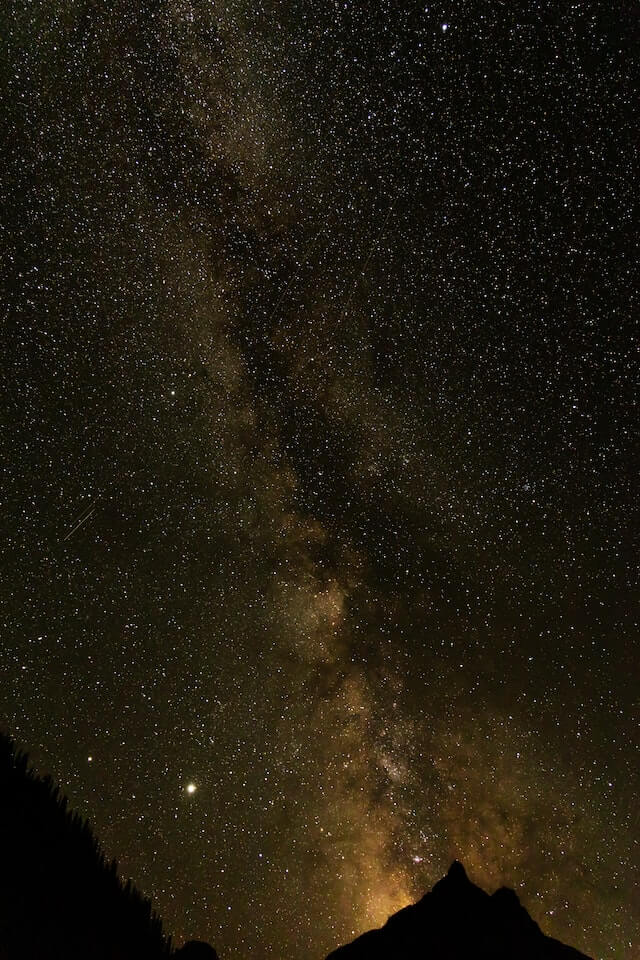
Glacier National Park also offers a nightly astronomy program, which is a great way to experience stargazing in Montana. The park management only offers these programs in the summer and reservations aren’t required.
One program takes place in Apgar on the west side of the park, and the other in St. Mary, on the east side. The St. Mary program utilizes the Dusty Star Observatory. Astronomers use the 20-inch telescope and astronomy camera to explore the stars, planets, galaxies, and nebulae of Montana’s night sky.
As I mentioned above, the view through the telescope is broadcast via large monitors for visitors to watch. We recommend bringing warm clothes suitable for windy conditions and foldable chairs, as seating is not provided. Sit back, relax, and enjoy an evening full of Montana stargazing.
2. Medicine Rocks State Park – Official dark sky area in Montana
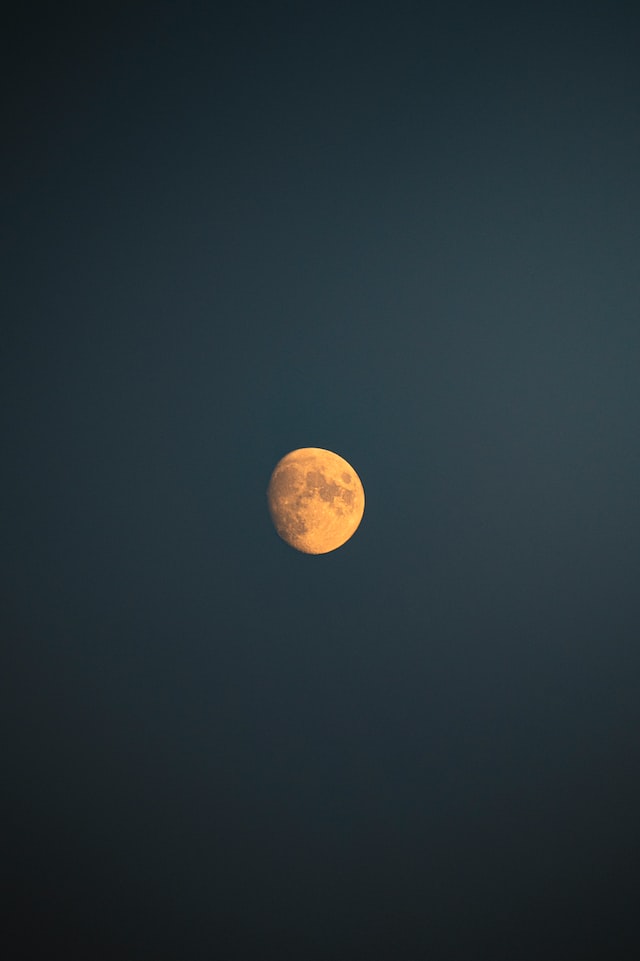
As its name implies, Medicine Rocks State Park is a former medicinal site for the local Native American tribes. Over centuries, the wind has slowly shaped the soft sandstone rocks, carving out holes and outcroppings, and creating some otherworldly rock formations. The park occupies about 300 acres of land, consisting of trails, picnicking sites, and campsites.
Medicine Rocks State Park is another of the official dark sky areas in Montana, making it perfect for stargazing and observing Montana’s sky at night. Many visitors come to stroll through the park by day, observing its rock formations and wildlife, such as antelope, mule deer, Woodhouse toads, and sharp-tailed grouse.
When the sun falls, they gaze up at the brilliant array of stars, galaxies, and the Milky Way spread across the purple Montana sky.
3. Brush Lake State Park – Official dark sky area in Montana

Brush Lake State Park is one of the most ideal places for stargazing aficionados. This park is located far off the beaten path, in northeastern Montana–a region with no large cities and no light pollution. The park encompasses 260 acres (105 hectares) of grass fields and a pristine lake with almost no trees in sight.
The lake is an officially designated dark sky area. It’s also a National Science Foundation research site. The water consists of sediments displaying 10,000 years of pollen and mineral deposits, which help tell the history of the earth’s climate since the Ice Age.
Anyone who visits this remote, beautiful region of Montana will have undisturbed views of Montana’s stars at night. The views of Montana’s sky at night from Brush Lake State Park are crystal clear. A campground sits on the northeast side of the lake with 12 campsites–perfect for a night in the RV with a telescope.
4. Yellowstone National Park Stargazing

Yellowstone National Park is another prime spot for stargazing. This 2,221,766-acre (899,116-hectare) park is a well-preserved ecosystem far from any large city or town. Its beautiful geysers, hot pots, mountains, valleys, and wildlife make for exceptional afternoons of exploring.
When the sun sets in Yellowstone, the stars come out. Guests who settle down in one of the many cabins, hotels, or campsites throughout the park are treated to an array of sparkling stars and galaxies spotted across Montana’s night sky. Stargazing in Yellowstone is a joy.
Experience Yellowstone with a local, expert guide
We partner with local expert guides in Yellowstone to offer you exquisite experiences in this world-renowned park. From twilight kayak trips on Yellowstone Lake to Lamar Valley riverside safaris, there’s a tour for everyone.
Pick an adventure and secure your spot today here.
If you decide to explore the park on your own, here are some of the top places to go stargazing in Yellowstone National Park:
- Dunrave Pass. Dunrave Pass sits at 8,859 ft (2,700 m) elevation and is the highest road in Yellowstone National Park. Here, visitors enjoy expansive and undisturbed views of Montana’s sky at night.
- Firehole Lake Drive. A 3-mile (5 km), one-way paved road off the Grand Loop Road through the Lower Geyser Basin. It’s easily accessible but far from the main, populated areas and towns.
- Lodges or Campsites. Staying at any of the lodges, campsites, or other accommodations throughout the park will give you a great opportunity to comfortably view the skies from within the park at the darkest hours.
ALERT: WALKING YELLOWSTONE AT NIGHT
Walking the boardwalks at night, you risk venturing off the designated pathways, which can easily be fatal. Stick to the campsite, lodge, trailhead, porch, picnicking area, or parking lot while stargazing in Yellowstone.
What are the best national parks in Montana? Find out here.
5. Beartooth Scenic Highway
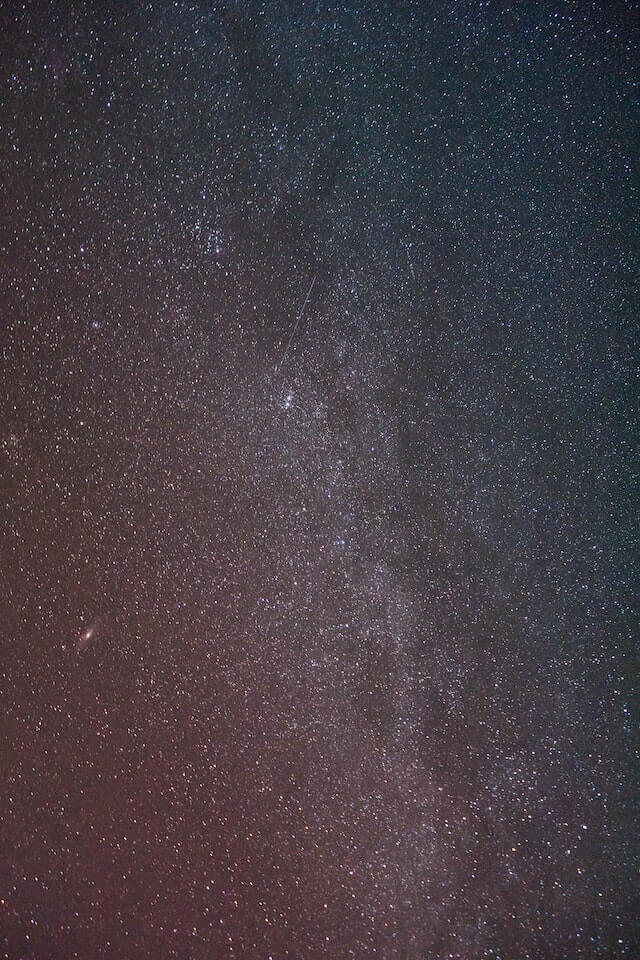
The Beartooth Scenic Highway (Highway 212) takes you about as close to the stars as one could possibly get in a car in Montana. The 68-mile (109 km) drive starts at the south edge of Red Lodge, Montana, one of the best places to visit in Montana.
There are several good campgrounds at the start of the drive just outside Red Lodge, before the road starts climbing the Beartooth pass, as well as up top on the Beartooth Plateau.
Stargazing spots near Red Lodge
These campgrounds sit in a forested valley where the sky is nestled between towering mountains on either side of the canyon. You won’t have endless, expansive views of the skies from here. Nonetheless, the views of Montana’s sky at night from here are crystal clear:
- Greenough Lake Campground. Located on the Rock Creek River south of Red Lodge, just before the start of the Beartooth Scenic Highway, on a bumpy road best suited for four-wheel-drive, high-clearance vehicles. It sits in a valley, though the views between the mountain tops are splendid.
- M-K Campground. On the same road as Greenough Lake Campground, but much further up the valley. A four-wheel-drive, high-clearance vehicle is necessary to reach the campground. Sits in the same valley as Greenough Lake Campground.
Past these campgrounds the road starts climbing, eventually switchbacking up a towering mountainside to the treeless tundra up top. Many sites along the way offer breathtaking views of the mountainous horizon and the valley below.
*BEAR ALERT: The Beartooth Range is notorious for its grizzly bear and other wildlife populations. While exploring outside Red Lodge or anywhere along the Beartooth Pass, always carry bear bells and bear spray at all times.
Stargazing spots from the top of the Beartooth Plateau
Once up top, continue across the tundra, slowly descending down the other side into Wyoming, past several more campgrounds that are ideal for Montana stargazing:
- Island Lake Campground. A beautiful campground located in the Wyoming portion of the drive, beyond the summit (coming from Red Lodge). This is a beautiful mountain lake surrounded by rock, sparse trees, and tundra–a pleasant setting for viewing Montana’s stars at night.
- Beartooth Lake Campground. A campground on Beartooth Lake, past Island Lake Campground further into Wyoming. This campground is in a similar environment, with tundra, pine trees, and a large rock bluff overlooking the lake.
But where are the best views?
The most expansive views are from Island Lake, Beartooth Lake, and the other campgrounds on the Wyoming side. From any of these points, you sit at a high elevation with endless views of Montana’s sky at night.
Self-guided Beartooth Highway audio driving tour
While driving, enjoy fascinating behind-the-scenes stories, local tips, and directions to the gems of the Beartooth Pass, including the iconic jagged tooth-like rock called the Bear’s Tooth.
Download the Beartooth Pass self-guided audio driving tour here.
6. Big Sky (Big Sky Ski Resort)
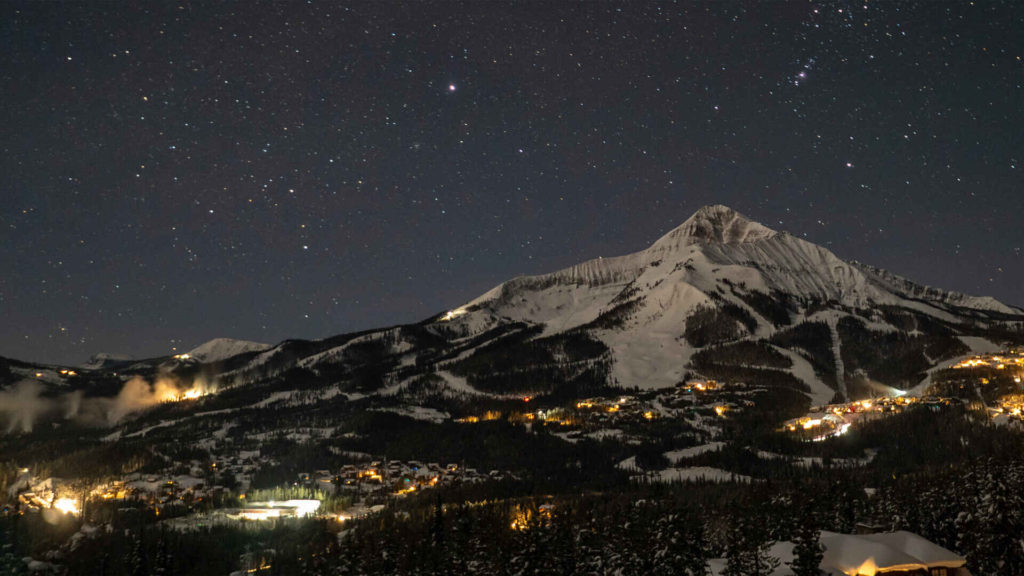
Big Sky is home to some of the best skiing in the United States. In the evenings, people rest after a day of cross-country skiing, alpine skiing, or strolling the streets of the meadow village. The restaurants fill up with people and lights flicker on in the many condos and houses surrounding the town center.
No matter where you stay in Big Sky, if you step outside at this time of night and gaze up at the sky, you’ll see an uncountable number of stars–Big Sky stars. Stars, planets, and nebulae of the Milky Way twinkle in the sky, clearly visible on most nights of the year. The Big Sky Montana night sky is a stargazer’s delight.
Where to stargaze in Big Sky Montana at night:
- On the ski hill. Put on your warm winter boots and clothing and take a stroll up the ski hill. Once you’re far enough from the base area, you’ll be enveloped in silence and the night sky, dotted with stars, planets, constellations, and the Milky Way. A prime spot for stargazing in Montana.
- Cross-country trails. Going for a night ski is a delightful way to breathe in some fresh air and see the crystal clear Big Sky Montana night sky.
- Beehive Basin parking lot. Drive out to the parking lot of Beehive Basin to escape the lights of the meadow and ski area. Here, you’ll enjoy expansive views of Montana’s sky at night. This is a wonderful place to see the Milky Way.
- Golf course. Any place on the 18-hole golf course in the Big Sky meadow will offer excellent views of Montana’s sky at night.
- Pretty much anywhere in Big Sky. Heading away from the town center or ski resort may offer a slight advantage for stargazing, but anywhere in Big Sky offers excellent views of Montana’s skies at night. Step out onto your balcony or your driveway and glance up at the sky–you’ll be delighted at how clear the Big Sky Montana night sky is.
Can you ride the chairlifts up the mountain at night and view the stars from the top?
Unfortunately, at the time of writing, the ski lifts at Big Sky Mountain resort aren’t open to the public after 4 pm.
7. Montana Hot Springs
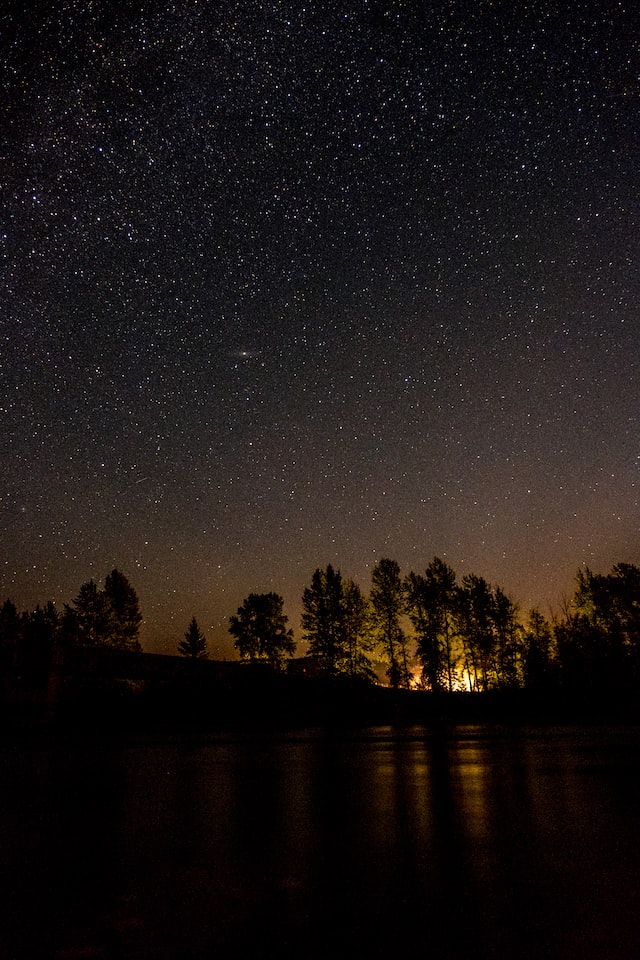
Montana has about 25 hot springs scattered throughout the state. What better way to enjoy Montana’s sky at night than to soak in a pool of steaming hot natural mineral water and gaze up at the star-speckled sky above?
Some of the best natural hot springs for viewing Montana’s sky at night are:
- Nimrod Warm Springs. Large, cool pool for swimming at the bottom of a large rock formation on the Clark Fork River. However, if you’re looking for hot bathing water, we suggest choosing another hot spring as the water here isn’t hot.
- Renova Hot Springs. Hot spring flows from the hillside into the manmade pots along the bank of an estuary of the Jefferson River. Renova Hot Springs offers great views across golden fields to the Highland Mountains on the horizon.
- Potosi Hot Springs. Beautiful hot springs estate with cabins in a wooded valley in the Tobacco Root Mountains.
Find a complete list of the best hot springs in Montana here and pick one for your next outing.
8. Paradise Valley
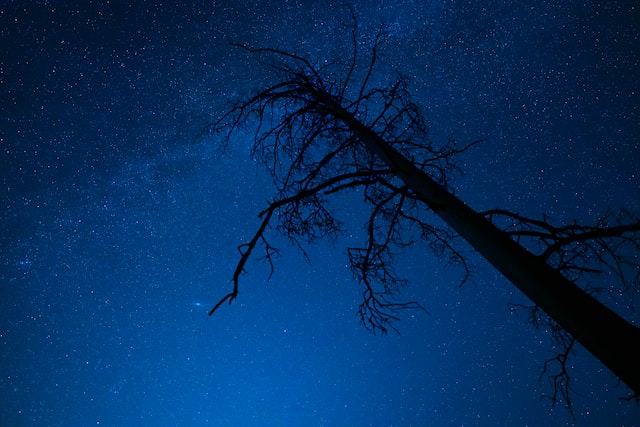
Anywhere in Paradise Valley is ideal for seeing the Montana sky at night. While a valley may not seem ideal for Montana stargazing, Paradise Valley is incredibly wide, consisting of vast, golden fields stretching between the Absaroka Range on the east and the Gallatin Range on the west. The valley floor offers expansive views of Montana’s sky at night.
Paradise Valley, Montana is located just south of Livingston and has become one of the top destinations in Montana for taking scenic drives, camping, visiting hot springs, and exploring Montana’s nature. It’s also on the way to Gardiner, Montana, a north entrance to Yellowstone National Park.
If you want to stargaze in Montana, we recommend booking one of the many lodges, cabins, or campsites and spending a couple of nights in this pleasant valley. On clear nights, the skies open up, making for breathtaking views of the stars.
Lodges, cabins, and campsites in Paradise Valley:
- Lodges
- Sage Lodge: A luxury Montana resort nestled in Paradise Valley with a spa and restaurant. A perfect place for Montana stargazing.
- Querencia Lodge: A rustic and warm lodge with several rooms offering views of the Gallatin, Absaroka, and Crazy Mountains. Another ideal lodge for Montana stargazing.
- Hotel/Bed&Breakfast
- Chicory House Bed & Breakfast: A cozy bed and breakfast on the Yellowstone River.
- Paradise Gateway B&B: A quaint estate offering rooms and vacation homes.
- Cabins
- Elk Cabin: A single cabin on the Yellowstone River with no neighbors, offering perfect, uninterrupted views of the valley and sky. A perfect spot for Montana stargazing.
- Emigrant Cabins: Cozy cabins featuring private porches perfect for stargazing.
- Camping/Glamping
- Mallard’s Rest Campground: Campground along the Yellowstone River without much tree cover offering open views of Montana’s sky at night (temporarily closed due to summer 2022 flooding).
- Loch Leven Campground: Campground on the Yellowstone River also without much tree cover, creating an excellent opportunity for Montana stargazing.
- Yellowstone Dreamin Camp: Agreeable glamping tents on wooden decks without any tree cover. Also ideal for Montana stargazing.
Another option is to stay and explore the beautiful nearby town of Livingston by day and take a scenic drive up Paradise Valley at night. Many visitors set off from Livingston in the evening and head up the valley. They pull into one of the many day-use areas, turn off the engine, and observe the skies above.
*BEAR ALERT: Paradise Valley is notorious for its grizzly bear and other wildlife populations. If you decide to hike or camp here, be sure to bring bear bells and bear spray. When camping, keep your food stored in locked containers, if provided, or suspended from a tree far from your campsite.
9. Small towns like Darby and Cut Bank, Montana
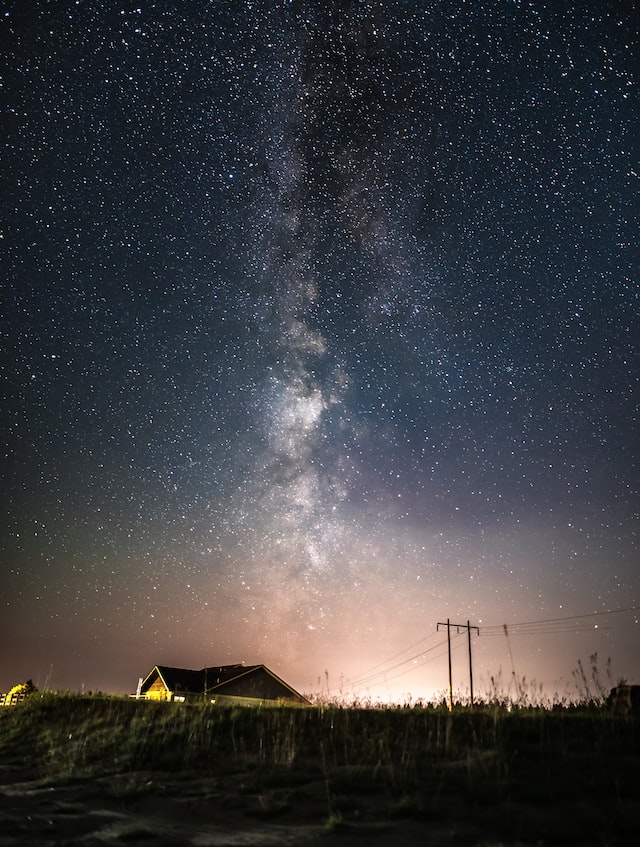
Small towns are some of the best places to see Montana’s sky at night. They generate very little light pollution and are often in some of the most picturesque regions of Montana. Stargazing from inside these towns isn’t bad, but with a car or bike, you can escape town in less than 30 minutes and find completely uninterrupted views of Montana’s sky at night.
Montana has a long list of quaint small towns. We recommend Darby, Montana, or Cut Bank, Montana:
- Darby, Montana is located in the beautiful Bitterroot Valley near Missoula, Montana.
- Cut Bank, Montana is located in northern Montana east of Glacier National Park, surrounded by beautiful prairie.
In these smaller towns, the Montana sky at night is endless.
10. Anywhere outside of any city or town
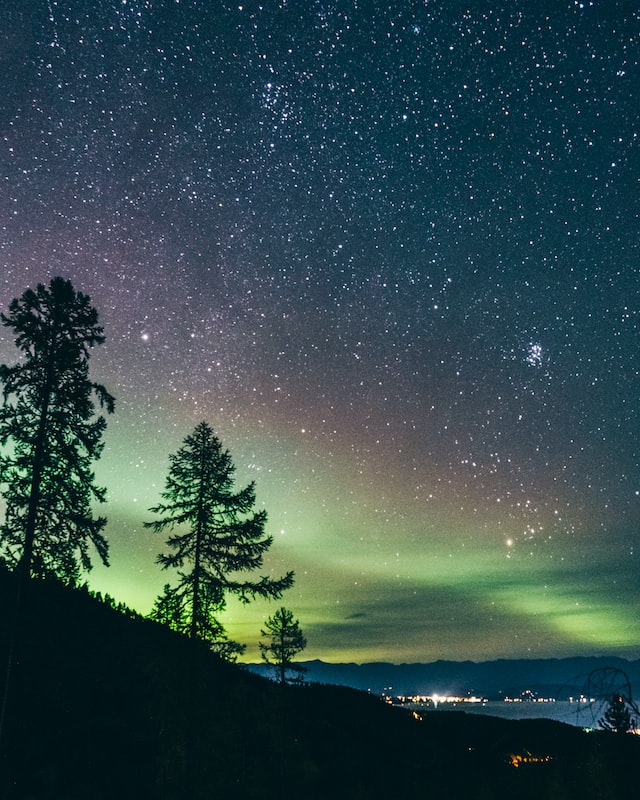
The beauty of Montana is that no matter which city or town you’re in, you’re never far from a wonderful place to view Montana’s sky at night. If you drive in any direction for more than 30 minutes, you’ll eventually find yourself among farm fields, vacant lots, rolling hills, or mountains–ideal places for viewing Montana’s sky at night.
Pull off to the side of the road, turn off the engine, step out of your car, and enjoy stargazing in Montana!

